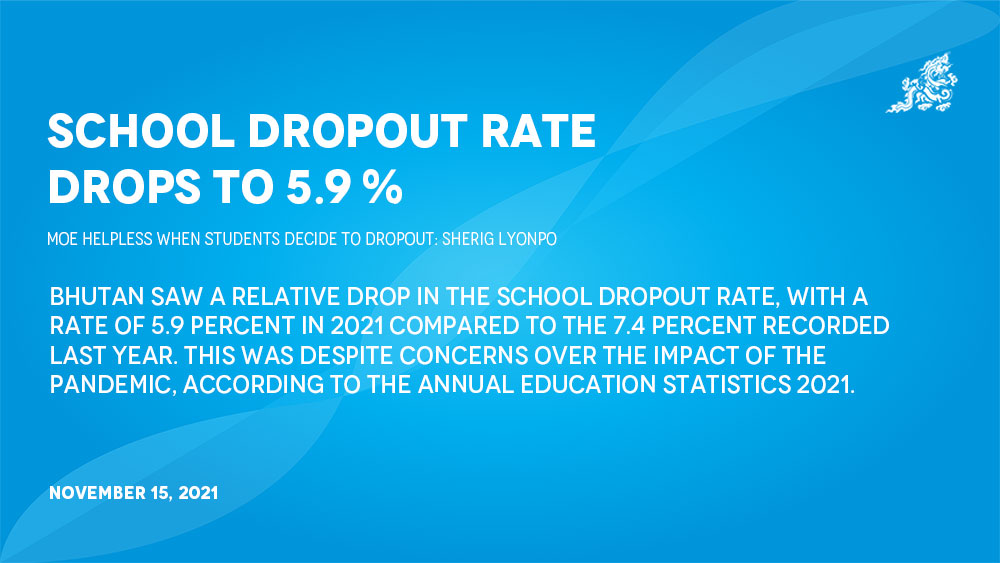MoE helpless when students decide to dropout: Sherig Lyonpo
Yangchen C Rinzin
Bhutan saw a relative drop in the school dropout rate, with a rate of 5.9 percent in 2021 compared to the 7.4 percent recorded last year. This was despite concerns over the impact of the pandemic, according to the Annual Education Statistics 2021.
The highest dropout rate of 5.9 percent this year was observed among students in Class VII.
The report, however, did not specify the reasons for students dropping out of school, nor did it reveal the exact number of dropouts that resulted in the 5.9 percent, which leads to questions about the accuracy of the dropout rate.
The specific number of dropouts was not available with the Ministry of Education (MoE).
According to the MoE’s definition, dropouts are students who leave the school system due to food insufficiency, disability, long travel distance to school, curriculum assessments and pedagogical factors, gender, economic reasons, and financial issues.
Dropouts do not include students who are repeating a grade level or who moved to another school or dzongkhag. Students leaving for employment or monastic education are not considered dropouts.
An official from the MoE said that since students often change schools or relocate to other dzongkhags, including many repeating the same class, it is difficult to get the specific number of dropouts.
“Until we are able to determine by headcount or students are visible in the villages, or engaged in non-schooling work, it is difficult to get accurate dropout data,” the official added. “However, we do determine the dropout rate.”
The dropout rate is usually calculated based on the repeaters and students’ promotion rate, meaning those students who do not fall under these two categories are considered as dropouts.
An official said that although there are unique student codes for each student, it was not possible to capture the exact number or reasons for dropping out, due to a lack of proper systems to record.
The MoE, meanwhile, is upgrading the Education Management Information System (EMIS) to Version 3, with a provision to determine exact data such as number of dropouts, including reasons.
The new EMIS is expected to roll out next year, which should address loopholes/shortcomings of data management, data inconsistencies, comprehensive data collection, validation, and accurate statistics.
The EMIS will record students’ academic performance to track progress. It will also produce education information from structures to the teacher-student ratio for annual education statistics.
Sherig Lyonpo Jai Bir Rai said that when it comes to reasons like marriage, parental decisions, or joining the monastic education route, it was difficult to bring students back to school.
Lyonpo said that although the dropout rate fell, students dropping out of schools is still a concern.
“Dropping out is a decision made by the parents or child,” Lyonpo said. “However, our concern lies with instances when the child drops out because of the school’s condition, insufficient food, or long travel distances.”
Lyonpo said that is why the ministry tries to create awareness on education and intervene as much as possible to retain students.
Regarding retaining students to continue their education, the ministry has contextualised the curriculum and deliverables based on the learning modalities that students are going through.
Schools are equipped with accelerated water and sanitation programmes, boarding provisions with school feeding, and children with disabilities are provided with mobile phones and tablets to support their learning.
“Maybe, because of these interventions, the dropout rate decreased,” Lyonpo said. “We hope that the dropout rate will eventually reach zero down the line.”


